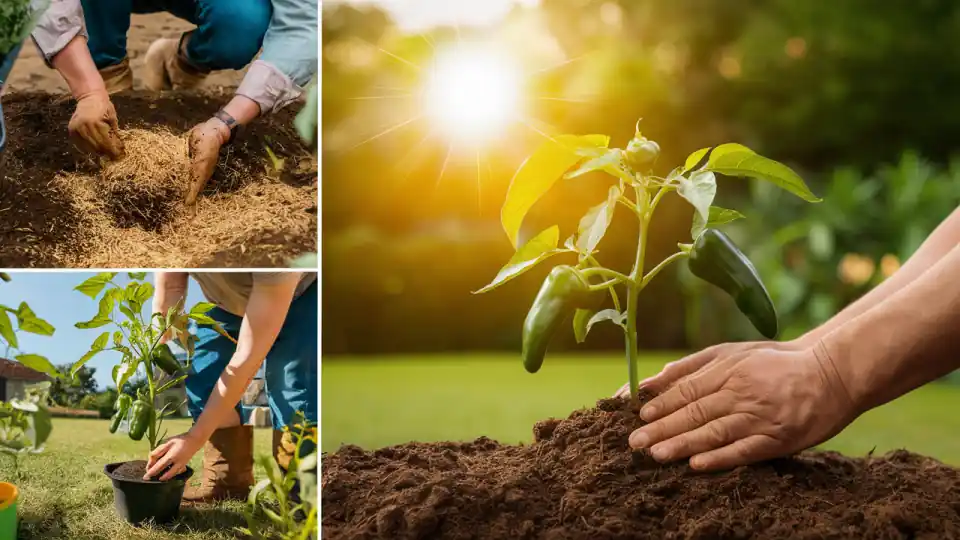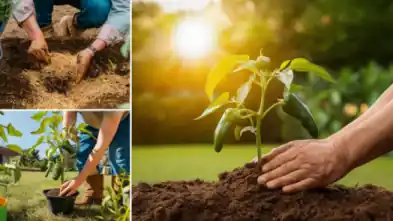
Unlock the Secrets of Flavorful Peppers: A Comprehensive Guide
Are you ready to transform your garden into a vibrant haven of spicy delights? Look no further! In this comprehensive guide, we delve into the art of growing pepper plants—from soil preparation and sunlight requirements to pest management and harvesting techniques. Whether you’re a seasoned gardener or a curious beginner, these insights will empower you to cultivate robust, flavorful peppers while reveling in the natural beauty of your home garden. Let’s embark on this green-fingered adventure together! 🌶️🌱🏡
Location and Space for pepper plant:
- Assess the space available in your garden. Pepper plants generally require a sunny location with well-drained soil.
- Ensure that the area receives at least 6 to 8 hours of sunlight daily.
- Space individual pepper plants approximately 18 to 24 inches apart to allow for healthy growth.
Vertical Gardening:
- Consider vertical gardening techniques to save space:
- Use trellises or stakes to support pepper plants as they grow upward.
- Hanging baskets or containers can also be used for compact varieties.
- Vertical gardening maximizes space and allows you to grow more peppers in a smaller area.
Remember to provide adequate care, including regular watering, proper fertilization, and protection from pests. Happy gardening! 🌶️🌱
2. Sunlight Requirements for Pepper Plant:
- Pepper plants have varying light preferences:
- Full Sun: Most pepper varieties thrive in full sun. Aim for at least 6 to 8 hours of direct sunlight per day.
- Partial Shade: Some peppers can tolerate partial shade, especially during hot summer afternoons.
- Full Shade: While not ideal, a few pepper varieties can grow in full shade, but they may produce fewer fruits.
Remember to choose the right location based on your pepper variety and local climate. Happy gardening! 🌞🌶️🌱
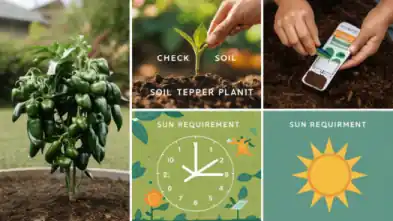
Certainly! Let’s continue with the same style for the next topic related to pepper plants:
3. Soil Conditions for Pepper Plant:
Soil Types:
- The ideal soil texture for pepper plants is well-draining and loamy.
- Loamy soil consists of a balanced mixture of sand, silt, and clay, allowing for proper water drainage while retaining enough moisture for the plants’ roots.
pH Adjustment:
- Pepper plants prefer a slightly acidic to neutral pH range of 6.0 to 7.0.
- Test your soil’s pH using a soil testing kit.
- Adjust the pH if necessary by adding organic matter (such as compost) or specific soil amendments.
- Avoid extreme pH levels (too acidic or too alkaline) to ensure optimal growth.
Remember to tailor your soil conditions based on the specific needs of your pepper plants. Happy gardening! 🌱🌶️🪴1234
4. Climate and Microclimates for Pepper Plants:
Climate Requirements:
- Pepper plants thrive in warm temperatures, typically between 70°F to 80°F during the day and 60°F to 70°F at night.
- Some pepper varieties, such as Capsicum pubescens, prefer cooler temperatures ranging from 45°F to 60°F and cannot tolerate extreme heat1.
Humidity:
- During flowering and fruit development, aim for a relative humidity (RH) between 65% and 85%.
- Too high humidity can invite fungal issues, while too low humidity can affect pollen viability2.
Remember to monitor your local climate and adjust as needed to create an optimal environment for your pepper plants. Happy gardening! 🌶️🌱🌤️
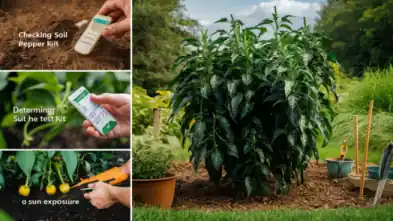
5. Planting Methods for Pepper plant
| Method | Rating | Reason | Expenses | Indoor | Outdoor | Fruit Growth | Maintenance Input | Conclusion |
|---|---|---|---|---|---|---|---|---|
| Seeds vs. Transplants | ⭐⭐⭐ | Starting from seeds allows customization; transplants provide a head start. | Low | Yes | Yes | Good | Moderate | Choose based on preference and timing. |
| Aquaponics | ⭐⭐ | Soil-based cultivation preferred for peppers; aquaponics can work but not optimal. | High | Yes | Yes | Fair | Moderate | Consider other methods unless you’re committed to aquaponics. |
| Back to Eden Gardening | ⭐⭐⭐ | Wood chips retain moisture and suppress weeds, benefiting pepper growth. | Low | Yes | Yes | Good | Low | Excellent for soil health and sustainability. |
| Biodynamic Gardening | ⭐⭐⭐ | Holistic approach enhances soil health; composting plays a significant role. | Low | Yes | Yes | Excellent | Moderate | Aligns with ecological principles; great for overall ecosystem. |
| Companion Planting | ⭐⭐⭐ | Deters pests and improves growth; choose compatible companion plants. | Low | Yes | Yes | Good | Low | Effective when strategically planned. |
| Raised Bed Gardening | ⭐⭐⭐ | Better drainage and soil control; ideal for peppers. | Moderate | Yes | Yes | Excellent | Moderate | Optimal for soil quality and space utilization. |
| Container Gardening | ⭐⭐⭐ | Works well, especially for compact pepper varieties. | Low | Yes | Yes | Good | Low | Convenient and flexible; suitable for small spaces. |
| Square Foot Gardening | ⭐⭐⭐ | Efficient use of space; divide planting areas into square-foot sections. | Low | Yes | Yes | Good | Low | Organized and space-saving; easy to manage. |
| Hydroponic Gardening | ⭐⭐ | Soil-less method; can yield decent results but not optimal. | High | Yes | Yes | Fair | Low | Consider other methods unless you’re committed to hydroponics. |
| Hügelkultur | ⭐⭐⭐ | Wood-based mounds improve soil fertility and water retention. | Low | Yes | Yes | Good | Low | Sustainable and beneficial for long-term growth. |
| Traditional Inground | ⭐⭐⭐ | Classic plot directly in the ground; natural and effective. | Low | Yes | Yes | Excellent | Low | Reliable and straightforward; suitable for most gardeners. |
| Vertical Gardening | ⭐⭐⭐ | Saves space; trellises and walls maximize growing area. | Low | Yes | Yes | Good | Low | Ideal for small spaces and urban gardening. |
| Edible Landscaping | ⭐⭐⭐ | Integrates peppers into landscape design; combines aesthetics with food production. | Low | Yes | Yes | Good | Low | Beautiful and practical; enhances overall garden appeal. |
| Window Box Gardening | ⭐⭐ | Accommodates compact pepper varieties; convenient for small spaces. | Low | Yes | Yes | Fair | Low | Perfect for balconies, windowsills, and limited areas. |
| Lasagna Gardening | ⭐⭐⭐ | Layered organic materials benefit peppers; no-dig planting. | Low | Yes | Yes | Good | Low | Soil-building method; sustainable and low maintenance. |
| Straw Bale Gardening | ⭐⭐ | Plant directly in straw bales; simple and compostable. | Low | Yes | Yes | Fair | Low | Suitable for temporary or experimental setups. |
| No Till Gardening | ⭐⭐ | Minimize soil disturbance; reduces weed growth. | Low | Yes | Yes | Good | Low | Environmentally friendly; requires less effort. |
Remember that the best method depends on your specific circumstances and preferences. Happy gardening! 🌱🌶️🪴
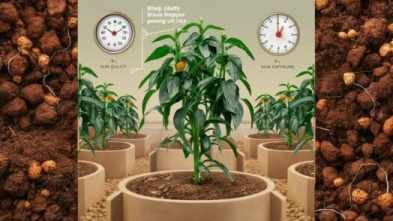
6. Seasonal Considerations for Pepper Plants:
- Fruit and Flower Times:
- Understand the timing of fruit and flower production for your pepper plants.
- Most pepper varieties take around 60 to 90 days from flowering to fruit maturity.
- Factors like temperature, light, and variety influence this timeline.
- Extending the Season:
- To prolong growth periods, consider:
- Cold Frames: These protect plants from frost and extend the growing season.
- Indoor Gardening: Grow peppers indoors using artificial light and controlled conditions.
- Both methods allow you to enjoy fresh peppers beyond the typical outdoor growing season.
- To prolong growth periods, consider:
Remember, adjusting planting times and using protective measures can enhance your pepper harvest! 🌶️🌱🌡️
7. Companion Planting for Pepper Plants:
- Buddy System:
- Pair peppers with compatible plants to enhance growth and natural pest control.
- Good companions for peppers include:
- Basil: Repels aphids and enhances pepper flavor.
- Marigolds: Deter nematodes and other pests.
- Chives: Ward off aphids and improve soil health.
- Tomatoes: Both benefit from each other’s presence.
- Avoid planting peppers near fennel or kohlrabi, as they may inhibit growth.
Remember, a well-chosen companion can be your pepper plant’s best friend! 🌶️🌱🌼
8. Pest Management for Pepper Plants:
- Natural Solutions:
- Combat common pests without harsh chemicals:
- Beneficial Insects: Introduce ladybugs and lacewings to feed on aphids and mites.
- Neem Oil: Spray plants to control pests while preserving beneficial insects.
- Insecticidal Soap: Safely manage pests without harming the ecosystem.
- Combat common pests without harsh chemicals:
Remember, a healthy pepper garden thrives with nature’s help! 🌶️🪲🌿
9. Watering and Drainage for Pepper Plants:
- Water Wisely:
- Understand your pepper plants’ water needs:
- Consistent Moisture: Keep the soil consistently moist but not waterlogged.
- Avoid Drought Stress: Peppers prefer evenly moist soil to prevent stress.
- Deep Watering: Water deeply to encourage strong root development.
- Understand your pepper plants’ water needs:
- Drainage Matters:
- Proper drainage is crucial:
- Well-Drained Soil: Use well-draining soil to prevent waterlogged roots.
- Elevated Beds: Raised beds or containers improve drainage.
- Mulch: Apply organic mulch to retain moisture while allowing excess water to escape.
- Proper drainage is crucial:
Remember, finding the right balance ensures healthy pepper plants! 🌶️💧🪴
10. Weeding and Maintenance for Pepper Plants:
- Tidy Garden:
- Regularly weed around your pepper plants to reduce competition for nutrients, water, and sunlight.
- Remove invasive weeds promptly to prevent them from overshadowing your peppers.
- Pruning Tips:
- Prune your pepper plants as needed:
- Remove Diseased or Dead Growth: Trim away any yellowing or damaged leaves.
- Pinch Off Suckers: Remove side shoots that emerge from leaf axils to encourage fruit production.
- Deadhead Flowers: After fruit set, remove spent flowers to redirect energy toward pepper development.
- Prune your pepper plants as needed:
Remember, a well-maintained garden yields healthy, productive peppers! 🌶️🌿🌼
11. Harvesting Techniques for Pepper Plants:
- Peak Flavor:
- Harvest peppers at their peak ripeness for the best flavor and nutritional value.
- Most peppers turn from green to their final color (red, yellow, orange) when fully ripe.
- Gently twist or cut the peppers from the plant to avoid damaging stems.
- Continuous Harvest:
- Peppers can be harvested repeatedly:
- Mature Fruits: Harvest mature fruits as they reach the desired color and size.
- Young Peppers: Leave some smaller, green peppers on the plant to continue ripening.
- Regular harvesting encourages new fruit production.
- Peppers can be harvested repeatedly:
Remember, timing matters for flavorful, abundant pepper harvests! 🌶️🍅🌱
12. Soil Health and Maintenance for Pepper Plants:
- Drainage Matters:
- Proper drainage prevents root rot:
- Raised Beds: Use raised beds or well-draining soil to avoid waterlogged roots.
- Mulch: Apply organic mulch to retain moisture while allowing excess water to escape.
- Proper drainage prevents root rot:
- Fertilize Right:
- Choose organic fertilizers for healthy pepper growth:
- Compost: Rich in nutrients and improves soil structure.
- Fish Emulsion: Provides essential nutrients without synthetic chemicals.
- Bone Meal: Boosts phosphorus for flowering and fruiting.
- Choose organic fertilizers for healthy pepper growth:
- Crop Rotation:
- Rotate crops annually to prevent soil depletion:
- Avoid Replanting Peppers: Move them to a different area each year.
- Benefit: Reduces disease risk and maintains soil fertility.
- Rotate crops annually to prevent soil depletion:
Remember, a well-maintained soil supports thriving pepper plants! 🌶️🌱🌿
13. Aesthetic Appeal for Pepper Plants:
- Visual Impact:
- Arrange and trim pepper plants strategically:
- Grouping: Cluster pepper plants for visual impact.
- Height Variation: Mix tall and short varieties for an interesting display.
- Borders: Use peppers as border plants or focal points.
- Arrange and trim pepper plants strategically:
- Colors and Textures:
- Consider aesthetics:
- Color Palette: Choose pepper varieties with vibrant colors (red, yellow, orange, green).
- Leaf Shapes: Combine different leaf shapes (smooth, wrinkled) for texture contrast.
- Companion Flowers: Plant marigolds or nasturtiums nearby for added beauty.
- Consider aesthetics:
Remember, pepper plants can be both flavorful and visually appealing! 🌶️🎨🌿
14. Sustainability Practices for Pepper Plants:
- Chemical-Free:
- Opt for organic methods:
- Natural Pest Control: Use neem oil, ladybugs, or other beneficial insects.
- Compost: Improve soil health without synthetic chemicals.
- Opt for organic methods:
- Beneficial Insects:
- Encourage pollinators:
- Bees: Plant bee-friendly flowers near your pepper garden.
- Butterflies: Create a welcoming habitat with nectar-rich plants.
- Encourage pollinators:
Remember, sustainable practices benefit both your peppers and the environment! 🌶️🌿🐝
15. Disease Prevention for Pepper Plants:
- Spacing Matters:
- Proper spacing helps prevent fungal issues:
- Air Circulation: Adequate spacing between pepper plants allows air to flow freely.
- Reduced Humidity: Good airflow minimizes humidity around leaves, reducing fungal risks.
- Avoid Crowding: Overcrowding can lead to damp conditions and disease spread.
- Proper spacing helps prevent fungal issues:
Remember, healthy spacing promotes disease-resistant pepper plants! 🌶️🌿🌬️
16. Adaptability to Changes for Pepper Plants:
- Weather Preparedness:
- Be ready for fluctuations:
- Temperature Swings: Pepper plants can be sensitive to sudden temperature changes.
- Covering: Use row covers or cloths during unexpected cold snaps.
- Be ready for fluctuations:
- Extreme Conditions:
- Protect plants during frost or heatwaves:
- Frost Protection: Cover plants with blankets or burlap if frost is expected.
- Shade Cloth: Shield plants during intense heat to prevent sunburn.
- Protect plants during frost or heatwaves:
Remember, adaptable care ensures resilient pepper plants! 🌶️🌦️🔥
17. Container vs. Ground Planting for Pepper Plants:
- Choose Wisely:
- Consider your space and preferences:
- Containers: Ideal for small spaces, balconies, or patios.
- Raised Beds: Improve soil quality and drainage.
- Direct Ground Planting: Traditional method with ample space.
- Consider your space and preferences:
- Small Spaces:
- Container gardening is a great solution:
- Pots: Use large pots with well-draining soil.
- Balconies: Grow peppers in containers for fresh produce.
- Mobility: Move containers as needed for sunlight.
- Container gardening is a great solution:
Remember, adapt your planting method to your available space and lifestyle! 🌶️🏡🪴
Conclusion
In this comprehensive guide to growing pepper plants, we’ve explored essential topics: from soil conditions and sunlight requirements to pest management and harvesting techniques. Remember to adapt your approach based on your available space, climate, and preferences. Whether you’re a seasoned gardener or a beginner, these insights will help you cultivate flavorful, vibrant peppers while enjoying the beauty of your garden. Happy growing! 🌶️🌱🏡

